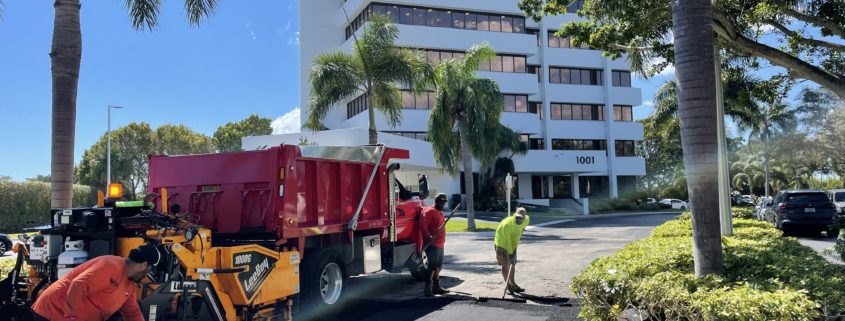What Is the Best Way to Repair Damaged Asphalt?
 There are many reasons why asphalt is the most popular paving material in North America. Compared to other materials, an asphalt pavement is less expensive and faster to construct. Asphalt pavements are safe, quiet, and visually attractive. Furthermore, they can have very long lives if they receive timely repairs and proactive maintenance. If you know that your pavement needs an asphalt repair, you may be wondering about your options.
There are many reasons why asphalt is the most popular paving material in North America. Compared to other materials, an asphalt pavement is less expensive and faster to construct. Asphalt pavements are safe, quiet, and visually attractive. Furthermore, they can have very long lives if they receive timely repairs and proactive maintenance. If you know that your pavement needs an asphalt repair, you may be wondering about your options.
How Do I Determine My Options for an Asphalt Repair?
When reviewing your options, it is important to remember that not all options are ideal for all types of asphalt damage. Therefore, it is critical to match the method to the type of asphalt damage you need to repair. It is also important to consider the longevity of the repair. Some repair methods may not last more than a year or so, but other methods may be permanent. Temporary repairs usually have lower initial costs, but they could add up to higher costs if you have to repeat them several times.
What Is the Most Popular Method of Asphalt Repair?
Asphalt patching is an extremely popular choice for many types of damage. Skin patching is a temporary method that is only suitable if the damage does not extend much below the surface. Full-depth patching can repair damage that extends through the entire depth of the pavement, including the foundation. Partial-depth patches are similar to full-depth patches, but they do not allow pavement maintenance contractors to access the foundation. Depending on the specific patching method, patches can repair potholes, alligator cracking, and many other types of asphalt damage.
What Is Another Popular Method for Repairing Asphalt Pavements?
Parking lot paving companies often consider asphalt resurfacing as an excellent solution to widespread damage. Your contractor may refer to this as installing an asphalt overlay. Essentially, the contractor uses a milling machine to grind off a precise depth of the existing asphalt. The depth can be as little as a few millimeters or as much as three inches. If the milling operation removed the damaged asphalt completely, the contractor can install new asphalt pavement to replace it. If not, the contractor can repair the exposed damage first. Resurfacing can repair a variety of problems, including some block cracks, raveling, and age-related deterioration. However, resurfacing is typically a bad choice for repairing alligator cracking. The contractor will not be able to repair the foundation, so the overlay will not last very long before it develops the same cracking pattern.
Are There Ways to Reduce the Need to Repair an Asphalt Pavement?
With the proper pavement maintenance, you can reduce the severity of the damage, or you may be able to prevent some it entirely. Here are some tips for maintaining an asphalt pavement.
1. Keep it clean. Remove oil, fuel, and other petrochemical fluids that vehicles may leak. Do not allow trash, leaves, or grass clippings to accumulate.
2. Maintain your asphalt sealcoating. Sealcoating is your pavement’s first line of defense against damage from water, sunlight, and automotive fluids. Most parking lots require fresh applications of sealcoating about every two years.
3. Keep vehicles that weigh more than your contractor engineered your pavement to support. For example, if your contractor engineered your parking lot to support personal vehicles only, keep heavy trucks or machines out.
Contact Asphalt Care Services if you have any additional questions about asphalt maintenance or repairing your pavement. We offer numerous services, including asphalt repairs, sealcoating, asphalt paving, thermoplastic line striping, concrete bumpers, parking lot striping, speed bumps, and traffic signs. We have an unparalleled reputation for craftsmanship, dependability, service, professionalism, and integrity. You can request a free job quote by calling 772-888-2840, emailing [email protected], or completing our online form.




